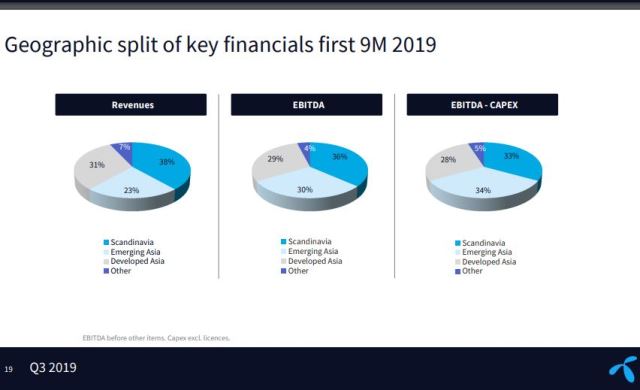Telenor Group has revealed how its business improved performance in several key telecom markets in Europe and Asia during the third quarter of 2019.

Norway
Telenor Norway achieved strong EBITDA growth of 4 percent from solid performance in all business areas and efficiency improvements.
Telenor has continued preparations for the copper network decommissioning, with network modernisation focused on fibre roll-out and mobile expansion, resulting in 12,000 new fibre connections and 6,000 new fixed wireless subscriptions in Norway.
The mobile operator launched the largest 5G pilot in Scandinavia on 26 September. Mobile subscription and traffic revenues grew 3 percent, mainly due to upselling to larger data bundles and increased demand for value added services.
Telenor Norway added 3,000 mobile post-paid subscriptions, partly offsetting reductions in prepaid subscriptions and data cards.
Telenor Norway achieved 25 percent growth in fibre revenues. Lower handset and other hardware sales were the main drivers for a decrease in total revenues of 3 percent. Opex decreased 5 percent, mainly from lower sales and operations costs.
Sweden
Telenor Sweden achieved reduction in the cost base due to efficiency initiatives. It added by 19,000 mobile subscriptions during the third quarter, driven by the consumer segment. Telenor Sweden’s mobile subscription and traffic revenues fell 3 percent, as the 2 percent larger subscription base did not fully compensate for the ARPU decrease.
Telenor Sweden added 9,000 high-speed fixed internet subscriptions in the quarter taking the total to 628,000. EBITDA declined 4 percent as the Opex reduction resulting from lower personnel, consultancy and maintenance costs could not offset the decline in subscription and traffic revenues and lower handset margin.
Capex increased by 10 percent, with investments this quarter being primarily related to IT modernisation and capacity upgrades.
Denmark
Telenor Denmark achieved 6 percent lower operating expenses due to focus on improvement in efficiency. The mobile subscription base ended at 1.7 million, which is 5 percent lower than a year ago. The smaller subscriber base in combination with 3 percent lower ARPU explains the revenue decline of 8 percent.
DNA Finland
Telenor has acquired 54 percent of the shares in DNA from Finda and PHP, and further increased its ownership to 97.96 percent following the initial mandatory tender offer that ended 10 October.
DNA’s third quarter revenue from mobile subscription and traffic rose 9 percent driven by the increased subscription base and higher ARPU. DNA added 10,000 mobile subscriptions during the quarter.
Gross profit increased by 5 percent driven mainly by higher mobile subscription and traffic revenues. EBITDA decreased slightly, as the increased gross profit was more than offset by non-recurring costs related to the ownership change, in addition to increased sales and marketing cost.
DNA’s Capex was 17 percent lower primarily due to reduced network investments. Spend was mainly related to 4G network capacity expansion and 5G readiness.
dtac – Thailand
dtac – Thailand achieved 2 percent growth in subscription and traffic revenues in September and stable for the full quarter. The effort to strengthen network and customer experience yielded results, with network NPS improving and fewer customer complaints.
Opex increased 8 percent as a result of higher operation and maintenance as well as energy cost mainly due to an expanded network, in addition to a reversal last year. EBITDA fell by 5 percent as a result of higher Opex.
dtac – Thailand’s Capex spend was focused on improving both indoor and outdoor 3G and 4G network quality in order to further strengthen dtac’s network quality. dtac has now 25,000 sites on air.
Digi Malaysia
Digi Malaysia faced 1 percent dip in subscription and traffic revenues due to reduction in prepaid voice.
Digi Malaysia posted cost increases due to the larger network and increased bad debt. Capex spend in Malaysia was focused on 4G network expansion and increased capacity to support the customers’ growing data demand with a better network experience.
Grameenphone Bangladesh
Grameenphone Bangladesh’s subscription and traffic revenues increased 7 percent during the third quarter. The subscription base increased by 0.4 million to 75.7 million, which is 6 percent higher than last year.
EBITDA of Grameenphone Bangladesh increased 5 percent driven by revenue growth and a healthy opex development despite pressure on commissions and regulatory costs. On 22 July, the Bangladesh Telecommunication Regulatory Commission (BTRC) imposed further restrictions on importing telecom equipment and software as well as tariff approvals. This has delayed the roll-out plan in Bangladesh and resulted in lower Capex.
Telenor Pakistan
Telenor Pakistan’s revenue from subscription and traffic fell 15 percent and EBITDA dropped 50 percent. The negative revenue was mainly caused by the disallowance of the service fee in the second quarter, but also lower ARPU.
Increased energy prices, network expansion and the devaluation of the local currency led to 8 percent higher Opex. Mobile subscriber base increased by 0.5 million, and the subscription base is now at a level which is 3 percent higher than last year.
Telenor Pakistan’s GSM license expired on 25 May, and the renewal fee was set to USD 449 million by Pakistan Telecommunication Authority (PTA). We claim that the renewal price should be USD 291 million, which is the same as prior renewals for other operators.
Myanmar
Telenor Myanmar added 1.8 million mobile phone customers during the quarter, taking the subscription base to 21.6 million. 60 percent of the customers are now active data users, with an average data consumption of 3.5 GB per month.
A 20 percent increase in the subscription base resulted in a subscription and traffic revenue growth of 2 percent.
Telenor Myanmar’s Capex was mainly related to the 4G network, site equipment and IT to support the growing business.





